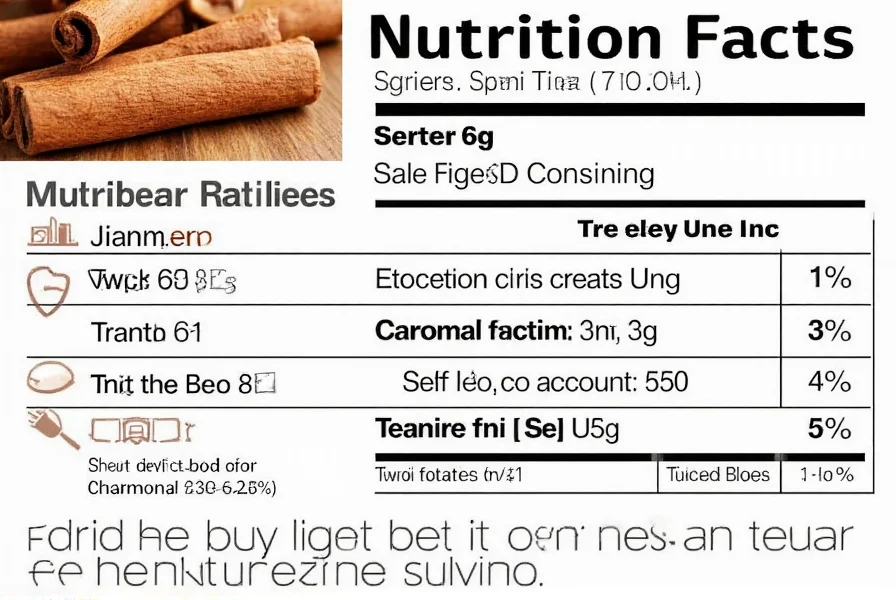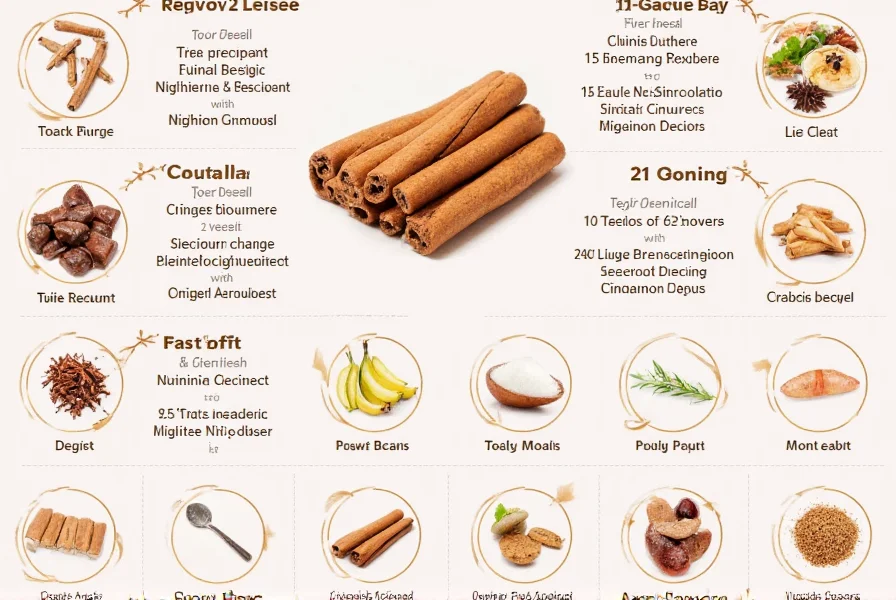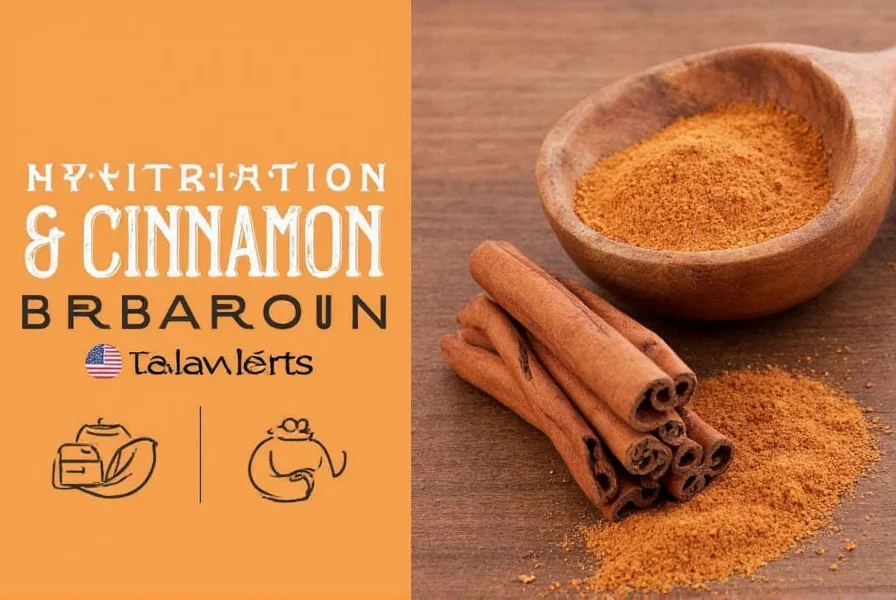One teaspoon (2.6g) of ground cinnamon contains approximately 6 calories, 2.1g carbohydrates, 1.0g fiber, and trace amounts of protein and fat. It's particularly rich in manganese (15% of daily value), calcium (4%), and iron (2%). Cinnamon also contains powerful antioxidants like polyphenols and offers potential health benefits for blood sugar regulation and inflammation reduction. Both Ceylon and Cassia varieties provide these nutrients, though Cassia contains higher levels of coumarin, a compound that may cause health concerns in large quantities.
When exploring cinnamon nutritional information, it's essential to understand both the impressive benefits and important considerations of this popular spice. As one of the world's oldest known spices, cinnamon has moved beyond flavoring to become a subject of significant nutritional research. This comprehensive guide delivers scientifically-backed data about cinnamon's composition, health impacts, and practical usage recommendations.
Nutritional Profile of Cinnamon
Cinnamon's nutritional value extends far beyond its distinctive flavor. This spice packs a powerful nutritional punch in a small serving size. Understanding the complete cinnamon nutrition facts per 100g helps put the teaspoon-sized servings into perspective.
| Nutrient | Per Teaspoon (2.6g) | % Daily Value* |
|---|---|---|
| Calories | 6 | 0% |
| Total Fat | 0.03g | 0% |
| Carbohydrates | 2.1g | 1% |
| Dietary Fiber | 1.0g | 4% |
| Sugar | 0.1g | 0% |
| Protein | 0.1g | 0% |
| Manganese | 0.2mg | 15% |
| Calcium | 26mg | 4% |
| Iron | 0.3mg | 2% |
*Percent Daily Values based on a 2,000 calorie diet. Values may vary based on specific cinnamon variety and growing conditions.
Ceylon vs Cassia: Understanding Cinnamon Varieties
Not all cinnamon provides identical nutritional information for cinnamon powder. The two primary varieties—Ceylon ("true" cinnamon) and Cassia (common in supermarkets)—differ significantly in composition:
- Ceylon Cinnamon: Lighter in color, more delicate flavor, lower coumarin content (0.004-0.12%), higher in certain antioxidants
- Cassia Cinnamon: Darker, stronger flavor, significantly higher coumarin content (1.0-6.0%), more widely available
For those seeking detailed cinnamon nutrition data with health implications, the coumarin difference is crucial. While coumarin has blood-thinning properties, excessive consumption may cause liver damage in sensitive individuals. The European Food Safety Authority recommends limiting coumarin intake to 0.1mg per kg of body weight daily.

Science-Backed Health Benefits
Research supports several health benefits associated with cinnamon consumption, making its nutritional value of cinnamon spice particularly noteworthy:
Blood Sugar Regulation
Multiple studies, including a 2013 review in the Journal of the Academy of Nutrition and Dietetics, indicate that cinnamon may improve insulin sensitivity and lower blood glucose levels. The compound cinnamaldehyde appears to mimic insulin and enhance glucose uptake by cells.
Antioxidant Powerhouse
Cinnamon ranks #1 among 26 popular spices for antioxidant activity according to research published in the Journal of Agricultural and Food Chemistry. Its polyphenols combat oxidative stress more effectively than many fruits and vegetables by weight.
Anti-Inflammatory Effects
The antioxidants in cinnamon, particularly cinnamaldehyde, demonstrate significant anti-inflammatory properties. Chronic inflammation contributes to numerous diseases, and cinnamon's compounds may help reduce inflammatory markers in the body.
Practical Usage Guidelines
Understanding cinnamon nutrition facts for dietary planning helps maximize benefits while minimizing potential risks:
- Recommended daily amount: 1-2 teaspoons (2.6-5.2g) of Ceylon cinnamon or ½-1 teaspoon (1.3-2.6g) of Cassia cinnamon
- Dietary incorporation: Sprinkle on oatmeal, blend into smoothies, add to coffee, use in baking as partial sugar substitute
- Storage: Keep in airtight container away from light and heat; ground cinnamon retains potency for 6-12 months

Safety Considerations
While cinnamon offers impressive nutritional benefits of cinnamon per serving, certain precautions are warranted:
- Coumarin sensitivity: Individuals with liver conditions should prefer Ceylon cinnamon and limit intake
- Medication interactions: Cinnamon may enhance effects of diabetes medications and blood thinners
- Allergic reactions: Rare but possible, especially with handling cinnamon powder
- Pregnancy: Moderate culinary use is generally safe, but therapeutic doses should be avoided
Conclusion
Cinnamon's impressive nutritional profile makes it far more than just a flavor enhancer. With its rich manganese content, potent antioxidants, and research-supported health benefits, this ancient spice deserves a regular place in a balanced diet. By understanding the complete nutritional breakdown of cinnamon and choosing appropriate varieties and quantities, you can safely enjoy both its culinary and potential health advantages. As with any dietary component, moderation and variety remain key principles for optimal nutrition.
Frequently Asked Questions
How much cinnamon should I consume daily for health benefits?
For Cassia cinnamon, limit to ½-1 teaspoon (1.3-2.6g) daily due to higher coumarin content. Ceylon cinnamon allows for slightly higher consumption at 1-2 teaspoons (2.6-5.2g) daily. These amounts provide potential health benefits while staying within safe coumarin limits for most adults.
Is cinnamon good for blood sugar control?
Research suggests cinnamon may improve insulin sensitivity and help lower blood glucose levels. A meta-analysis in the Journal of Medicinal Food found that 1-6 grams daily reduced fasting blood glucose by 18-29 mg/dL in people with type 2 diabetes. However, it should complement—not replace—standard diabetes management.
What's the difference between Ceylon and Cassia cinnamon nutritionally?
Both varieties offer similar micronutrient profiles, but Cassia contains 10-50 times more coumarin than Ceylon cinnamon. Ceylon typically has slightly higher antioxidant levels. Nutritionally, they're comparable in calories, carbohydrates, and mineral content per serving, but the coumarin difference significantly impacts safety considerations for regular consumption.
Can cinnamon help with weight loss?
While cinnamon isn't a weight loss miracle, it may support metabolic health. Some studies suggest it can improve insulin sensitivity, potentially reducing fat storage. Its ability to moderate blood sugar spikes after meals might help control cravings. However, significant weight loss requires comprehensive dietary and lifestyle changes, with cinnamon serving as a supportive element rather than primary solution.
Does cinnamon lose nutritional value when cooked?
Most of cinnamon's key compounds, including cinnamaldehyde and polyphenols, remain stable during cooking. Some water-soluble compounds may leach into liquids, but the spice generally retains its nutritional properties through typical baking and cooking processes. For maximum antioxidant retention, adding cinnamon toward the end of cooking may preserve slightly more beneficial compounds.











 浙公网安备
33010002000092号
浙公网安备
33010002000092号 浙B2-20120091-4
浙B2-20120091-4